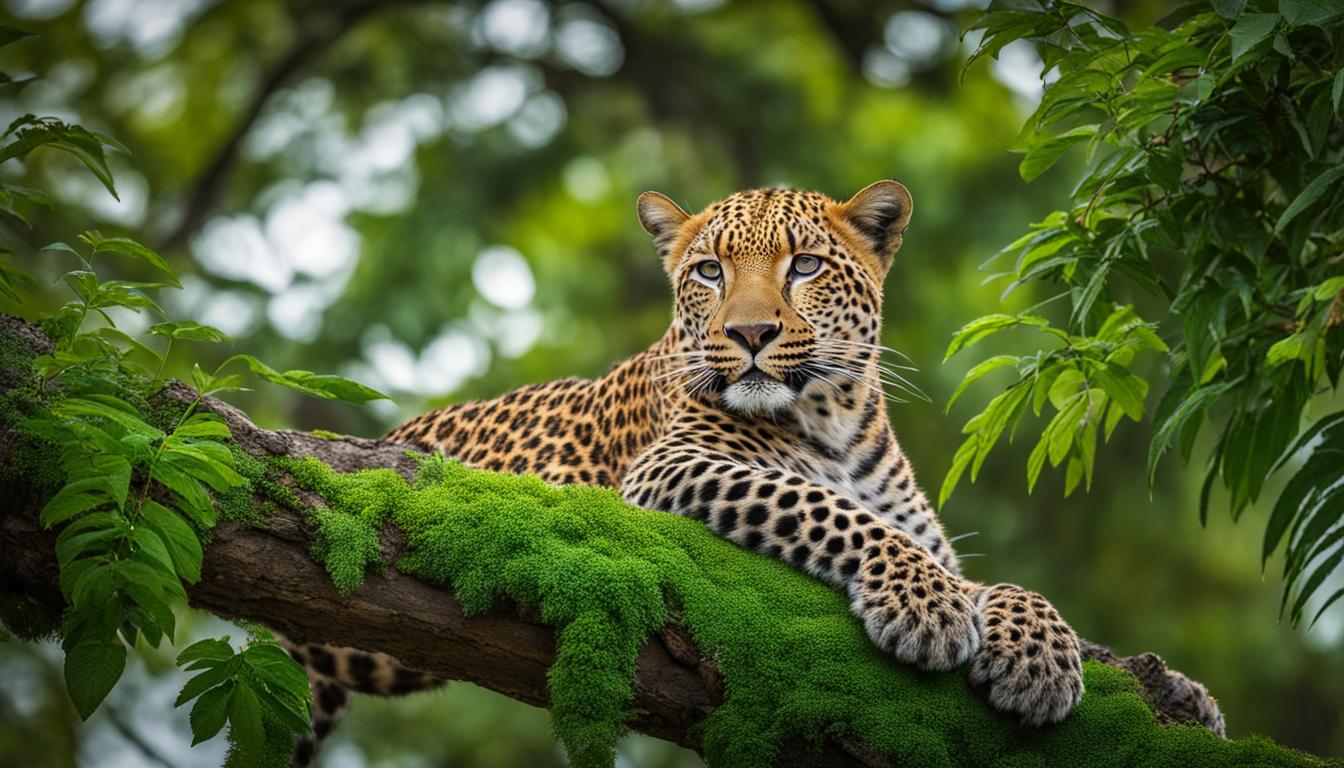Leopards are fascinating creatures with unique behaviors and adaptations. One behavior that sets them apart is their ability to climb trees. In this section, we will explore the reasons behind leopard tree climbing, their behavior in their natural habitat, and the adaptations that allow them to navigate branches with ease.
Leopard tree climbing is a behavior that can be observed in certain habitats where leopards reside. While it is not something they do regularly, climbing trees serves various purposes for these magnificent big cats.
Their tree climbing behavior can be seen in the Lowveld region, where adult leopards engage in hoisting their kills to keep them safe from scavengers. They also climb trees to investigate branches with the scent of a previous kill or seek refuge from predators like wild dogs, hyenas, or lions. Additionally, younger leopards may climb trees for play and practicing their climbing skills.
Leopards possess specific adaptations that make them adept climbers. Their lightweight bodies, powerful forelimbs, protractile claws, free front limbs, mobile backbone, and long, sturdy tails enable them to thrive in their habitat and navigate the branches with agility.
In the following sections, we will delve deeper into the benefits of leopard tree climbing, the abilities of other African animals in climbing trees, their preferences for specific tree species, and the conservation efforts to protect these incredible creatures and their unique behaviors.
The Benefits of Leopard Tree Climbing
Leopards possess remarkable tree climbing abilities that provide them with numerous benefits in their natural habitat. By ascending to the treetops, leopards gain a strategic advantage in their hunting endeavors. From an elevated position, they can survey the area, spotting potential prey and assessing any potential threats. This elevated vantage point allows leopards to plan their approach and execute precise attacks, increasing their chances of a successful hunt.
Climbing trees also offers leopards a safe haven from their adversaries. When threatened by larger predators like lions or hyenas, leopards can quickly retreat to the safety of the trees, where their agile movements and keen senses give them the upper hand. By escaping into the branches, leopards gain an advantage in both offense and defense, showcasing their adaptability and survival instincts.
Furthermore, climbing trees allows leopards to rest and consume their meals comfortably. Once they have made a kill, leopards often hoist their prey into the trees, keeping it out of reach from scavengers. This behavior not only protects their hard-earned meal but also allows them to enjoy their feast undisturbed, unburdening their bellies and reducing the risk of losing their food to competitors.
Leopard Tree Climbing Techniques
Leopards utilize a variety of techniques when climbing trees. Their powerful forelimbs and sharp, retractable claws are their primary tools for gripping and scaling branches. They exhibit incredible agility as they navigate the intricate network of branches, using their long tails for balance.
Leopards employ an impressive combination of strength, balance, and coordination when ascending trees. They often use a combination of front and hind legs to propel themselves upward, employing a zigzag pattern to navigate around obstacles and select the most secure branches. Their muscular bodies and flexible spines enable them to contort themselves into different positions, allowing them to move with ease through the treetops.
| Leopard Tree Climbing Techniques | Description |
|---|---|
| Branch Exploration | Leopards climb trees to investigate branches with the scent of a previous kill, which helps them pinpoint potential food sources. |
| Resting and Feeding | By ascending trees, leopards can rest and consume their meals comfortably, away from ground-level threats and scavengers. |
| Escape and Safety | When evading predators or seeking refuge from danger, leopards rely on their climbing skills to quickly ascend to the safety of the treetops. |
| Hunting Strategy | Leopards strategically climb trees to pursue arboreal animals and mammals with good tree climbing skills, capitalizing on the element of surprise to launch successful attacks. |
Overall, leopard tree climbing showcases the adaptability and skill of these magnificent creatures. It is a behavior that not only aids in their survival but also highlights their unique attributes and remarkable agility. Witnessing a leopard gracefully maneuvering through the branches serves as a testament to their incredible capabilities and reminds us of the diverse range of strategies employed by animals to thrive in their respective habitats.
Tree Climbing Abilities of Other African Animals
While leopards are known for their exceptional tree climbing abilities, they are not the only African animals that engage in this behavior. Let’s explore the tree climbing habits of other magnificent creatures in the African wilderness.
Tree-Climbing Lions
Despite their size and bulkiness, lions have been observed climbing trees on occasion. However, their climbing abilities are limited compared to leopards. Lions typically stick to the lower branches of trees, like acacia and sausage trees, which provide more support. They may climb to escape the heat, insects, or to get a better view of their surroundings.
Cheetahs
Cheetahs, known for their incredible speed and agility on land, are not natural climbers like leopards. They generally prefer to stay closer to the ground, utilizing their remarkable sprinting abilities to chase down prey. While cheetahs can climb trees if necessary, it is not a behavior they commonly exhibit.
Hyenas
Unlike leopards, hyenas lack the necessary physical adaptations for tree climbing. Their bodies are not built for the agility and power required to navigate tree branches. Hyenas primarily rely on endurance running and their strong jaws for hunting and scavenging, making them ground-dwelling animals.
As we can see, among the African big cats, leopards stand out as the true masters of tree climbing. Their unique adaptations and versatile climbing skills allow them to navigate the treetops with precision and grace. This behavior gives leopards an advantage in various aspects of their lives, including hunting, protecting their kills from scavengers, and seeking refuge from predators.

Leopard Tree Preferences and Behavior
Leopards in different regions display preferences for specific tree species when it comes to their climbing behavior. In the dry zone of Sri Lanka, for instance, leopards favor trees such as Palu, Maliththan, Tamarind, and Dang. These trees provide sturdy branches and ample coverage, offering leopards a secure vantage point for hunting and resting. In national parks where leopards are more protected, they may be more comfortable staying in trees even in the presence of humans. However, in unprotected wilderness areas, leopards tend to climb down at the slightest hint of danger.
Conservation efforts play a crucial role in safeguarding leopard populations and their unique tree-climbing behavior. By preserving their natural habitat and minimizing human interference, conservationists strive to ensure the survival of these majestic creatures and their intricate relationship with trees. Careful monitoring and management of leopard populations are necessary to prevent further decline and maintain the delicate balance within ecosystems where leopards reside. Additionally, raising awareness about leopard tree conservation can inspire individuals to appreciate and protect these magnificent creatures.
Leopard Tree Sightings
Observing leopards in trees offers a rare and incredible opportunity to witness their natural behavior. While it may require patience and a keen eye, encountering a leopard perched on the branches can be a truly awe-inspiring experience. Professional wildlife photographers and dedicated wildlife enthusiasts often share their remarkable leopard tree sightings, capturing these beautiful creatures in their element. These sightings further highlight the adaptability and resilience of leopards as they navigate their arboreal habitat.
| Region | Prevalent Tree Species |
|---|---|
| Sri Lanka | Palu, Maliththan, Tamarind, Dang |
| African National Parks | Various indigenous trees |
As more people become aware of leopard tree climbing behavior, the significance of documenting and reporting sightings increases. Researchers and conservation organizations rely on these reports to gather valuable data and gain insights into leopard populations, behavior patterns, and habitat preferences. Sharing your leopard tree sightings can contribute to the collective knowledge and understanding of these fascinating creatures.
Conclusion
Leopards are truly remarkable creatures with their extraordinary ability to climb trees. This behavior sets them apart from other big cats and showcases their incredible adaptability in their natural habitat.
Through their climbing skills, leopards can hoist their kills into the safety of the branches, keeping them protected from scavengers. They also use trees as a resting spot after a meal, providing them with a comfortable vantage point to survey their surroundings. Additionally, leopards rely on their tree-climbing prowess to hunt arboreal prey, utilizing the element of surprise and their own body weight to effectively capture their targets.
The physical adaptations of leopards, such as their lightweight bodies, powerful limbs, protractile claws, and long tails, enable them to navigate the branches with grace and agility. These adaptations, combined with their climbing skills, allow leopards to thrive in their habitat and successfully overcome various challenges they face in the wild.
Do leopards and cheetahs have similar reasons for climbing trees, or is it different for each species?
The cheetahs climbing trees debate is ongoing among wildlife experts. While both leopards and cheetahs are known to climb trees, the reasons behind this behavior may differ. Leopards often seek refuge or store prey in trees, while cheetahs may climb for a vantage point or to escape predators.
FAQ
Can leopards climb trees?
Yes, leopards have the ability to climb trees.
Why do leopards climb trees?
Leopards climb trees for various reasons, including hoisting kills to keep them safe, investigating branches with the scent of a previous kill, seeking refuge from predators, and practicing their climbing skills.
Do leopards spend most of their time in trees?
No, most of a leopard’s time is spent on the ground rather than in trees.
What physical adaptations enable leopards to climb trees?
Leopards have lightweight bodies, powerful forelimbs, protractile claws, free front limbs, mobile backbones, and long, sturdy tails that facilitate their climbing abilities.
How do leopards benefit from climbing trees?
Climbing trees allows leopards to have a higher vantage point for spotting prey, protection from enemies, a comfortable resting spot after a meal, and the opportunity to hunt arboreal animals.
Do other African animals climb trees?
Some African animals, such as tree-climbing lions, engage in tree climbing to a limited extent. Cheetahs do not climb trees, and hyenas lack the agility and power needed for tree climbing.
Do leopards have preferences for specific tree species?
Yes, leopards in different regions show preferences for specific tree species when it comes to climbing.
How can leopard tree climbing be observed?
Conservation efforts are crucial in ensuring the survival of leopard populations and their unique tree-climbing behavior. Sightings of leopards in trees offer a rare and incredible opportunity to witness these majestic creatures in their natural habitat.










